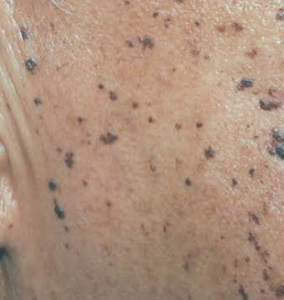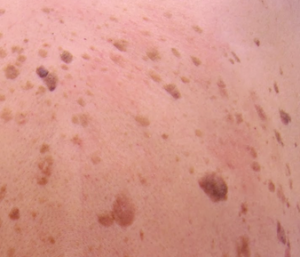Skin barnacles are benign growths that develop on the skin of people as they age. Skin barnacles are also called seborrheic keratoses. They develop mostly on your chest or back. But they can appear anywhere on your body. Skin barnacles grow gradually in clusters or singly on your body. They are common and many people develop one Skin barnacles during their life time.
Skin barnacles are similar in structure to warts because they are formed as a result of excess skin cells that are made of dead and living cells. The living cells that make additional layers of the dead cells are known as stratum corneum.
Skin barnacles are usually not harmful but can affect your appearance and make you feel embarrassed to socialize. You will need treatment to remove them as well as an evaluation to determine if they are cancerous or not.
Symptoms of Skin Barnacles
The following are signs and symptoms that can help you identify a skin barnacle:
- Skin barnacles are either brown or flesh in color and they look like warts. They develop on many parts of your body apart from the palms of the hand and soles of the feet. They begin to develop when you are 30 years and continue to increase as you age.
Diagnosis of Skin Barnacles
If you notice new growths on your skin, seek medical help. Some of these growths may be malignant and it is important if you have them checked by a dermatologist. Your doctor will physically examine your skin and study the symptoms to get more details about your condition.
Your dermatologist can order a skin biopsy to find out the cause of the condition. In skin biopsy, your doctor extracts a sample of the affected skin and analyses it in the laboratory for pathogens. This will help your doctor determine the type of microorganisms responsible for causing this condition. This test will also help your doctor exclude other related skin conditions as the cause of the problem.
Treatment for Skin Barnacles
Most of the skin barnacles are not harmful and some people choose to leave them. However, if these growths bleed and cause irritations, it is better you look for treatment. The following treatment options can be used to get rid of skin barnacles:
Cryosurgery: This is a medical procedure that uses extremely cold temperatures to freeze abnormal growths on your skin. In cryosurgery, carbon dioxide, argon gas or liquid nitrogen can be used to remove these overgrowths.
In cryosurgery, you will be given some instructions to follow prior to this procedure. You will also inform your health professional if you are allergic to anesthesia and medicines you have been taking.
Your doctor will inject anesthesia near the skin barnacles to reduce pain and make you comfortable during the procedure. Liquid nitrogen is put on a clean cotton cloth and placed directly on the affected skin or it is sprayed.
Cryosurgery can cause a number of undesirable effects such as it can injure close tissues and blood vessels. It may also cause blisters to form at the place of surgery.
Excision: Skin barnacles can be eliminated through excision. In this procedure, your doctor uses a sharp object such as razor blade to extract the barnacle on your skin.
Electrosurgery: This method uses electric current to remove the skin barnacles. In this procedure, your doctor passes a low electric current from a battery to the affected skin. This stops blood flow to the barnacle and it is then cut and discarded from the skin. Electrosurgery is very effective in removing large skin barnacles.
Laser: This treatment method uses focused light to remove a skin overgrowth. Lasers are good because they help your doctor boost precision during surgery by focusing on a small area. There are numerous laser therapies your doctor can choose from to remove the skin barnacles and this is influenced by the nature of the overgrowth.
In this procedure, light is focused on the affected area at a particular wavelength to destroy the skin barnacle. Laser therapy can cause bleeding, pain and infections at the site of operation.
Home remedies: There are several self-care tips you can try at home to prevent skin barnacles such as:
- Take care of the wound: Wash the wound with antibacterial soap to get rid of infections. This should be done regularly.
- Stop scratching the wound: Scratching the skin barnacle can cause them to bleed and become prone to infections. Try as much as possible to avoid starching the affected area. You can prevent this by covering the wound with a bandage or a loose cloth.
- Use antibacterial cream: Antibacterial cream or anti-itch cream can help stop further infections and itching in your wound. You can get this medication from over-the- counter or ask your doctor to prescribe one for you. Once you have this medication, apply them on the affected area as directed by your doctor to get relief from skin barnacles.


